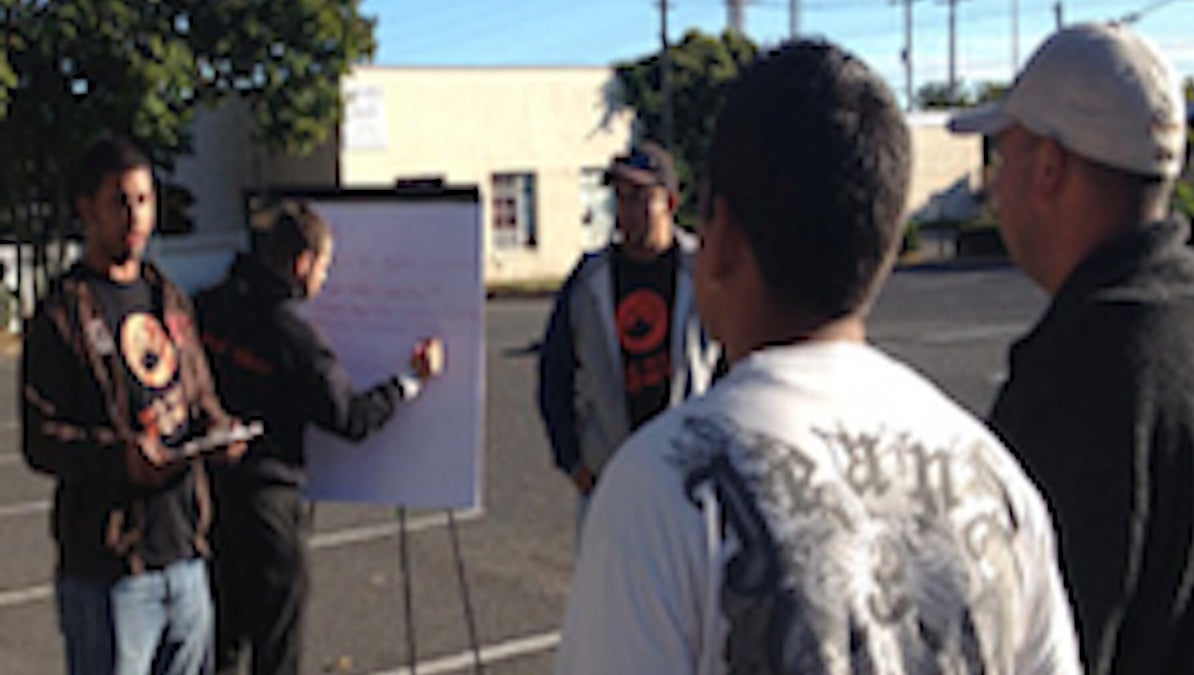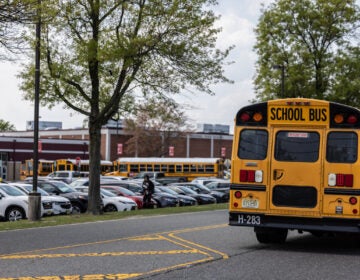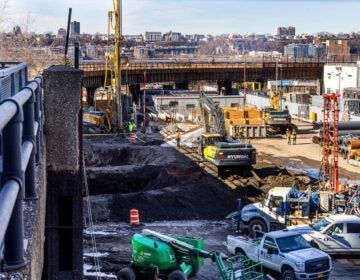Sandy poses special problems for immigrant day laborers aiding recovery effort
Listen
Labor organizer Jonas Mendonza leads a class to teach workers about their rights. (Courtesty of Scott Gurian/NJ Spotlight)
“After Sandy, I went to work with a contractor doing a basement cleanup,” recalled Marcelo, a day laborer from Brazil who’s been living in the U.S. for the past seven years but didn’t want to give his last name because he’s not authorized to work here. “We were taking down a sheetrock framing, and I got hit by a hammer on my head.”
He bled a little, but remembers thinking at the time that his injuries weren’t that bad, so he cleaned himself up and kept working. “That day I didn’t have gloves, I didn’t have goggles, I didn’t have a helmet. No safety equipment,” he said.
The next morning, he started to have headaches, which continued for several days. “I said to myself, you know, I’d better go to the doctor, because maybe something’s damaged inside,” he recalled. So he went to the hospital, had some x-rays taken, and eventually the headaches went away.
One week later, a bill arrived in the mail. It was close to a thousand dollars, and Marcelo didn’t have insurance. So he contacted his boss from the job site where he had sustained his injury. “He said, ‘That’s impossible. I don’t know you. You don’t have legal documents to work for me. I can’t help with that. You’re on your own right now,'” Marcelo remembered. So he ended up scraping up the money to pay the bill himself.
After any major disaster, day laborers are often among the first to report to the frontlines of the cleanup and recovery effort, drawn by the increased demand for work and the promise of picking up extra hours.
But as noted in a new report from the City University of New York’s Baruch College School of Public Affairs, disasters, by their very nature, tend to create additional occupational hazards and safety issues for both workers and employers, for which there is often little training.
Sandy is no exception. As part of the recovery effort, workers may be exposed to mold and other toxic substances they might not ordinarily come across. And they may be given unfamiliar tasks, sometimes without fully understanding the dangers and the risks.
Immigration Project
Immigrant rights groups say the experience of Sandy emphasizes the need for day laborers and their organizations to be systematically incorporated into future disaster planning and recovery efforts, so that worker health and safety take greater priority.
In addition to potentially unsafe working conditions, many day laborers working on the Sandy recovery have also faced problems with being underpaid or — in some instances — not paid at all for work they’ve done.
To be clear, many of these problems have always existed for this segment of the labor force, where many workers don’t speak English. They may be unaware of their rights and are often afraid to seek help or report violations out of fear they may be blacklisted from future work assignments or deported.
As the federal agency tasked with protecting workers’ rights and wellbeing, the U.S. Department of Labor is aware of the challenges presented by disaster recovery scenarios.
“What it is is a chaotic environment into which you’re putting a big, ad hoc workforce,” explained Patrick Reilly, Director of the Department’s Wage and Hour Division for Southern New Jersey. “You have damaged or absent infrastructure, and you are bringing in a lot of workers very often from outside the area. And they’re trying to get work done quickly and trying to get people’s lights back on and the water running again and all the utilities going, the streets open and so forth. And there’s an immediacy to it that may lead employers to say, ‘Well, I’m not going to worry about the labor standards. I need to get this done.'”
Anticipating potential problems, the department stepped up its outreach efforts in the aftermath of Sandy, handing out business cards with phone numbers for workers to report problems, along with calendars so they could keep track of their hours.
While those efforts may have helped in some cases, many workers like Hernán still experienced their share of difficulties. Hernán (like Marcelo, he didn’t feel comfortable giving his last name) arrived in New Jersey from Guatemala shortly after the storm, looking for work. While he didn’t actually come as a result of Sandy, his timing was advantageous, as he found plenty of jobs repairing roofs, removing sheetrock, spackling, and doing miscellaneous construction. Even now — a year later — he still keeps pretty busy doing cleanup work up and down the coast. But all this has come at a cost.
“There were many poisons and chemicals. We didn’t know that things could be that dangerous until our bodies started to show the effects,” he said, echoing accounts from fellow workers who reported rashes, allergies, vomiting, respiratory problems, and a variety of on-the-job injuries.
“For example, it’s not good when we’re working where there’s been standing water mixed with sewage because it’s contaminated with bacteria,” he continued, speaking through a translator. “In the end, it’s the workers who suffer the most. I think that that wasn’t taken into consideration.”
Measuring the scale of the problem
Since the day labor workforce is transient and operates largely out of the public eye, getting a handle on the scale of the problem can be difficult.
But by one account, over 90 percent of the 11 day-labor worker centers in New York and New Jersey that responded to the CUNY survey said that they had seen or heard of workers being exposed to hazardous materials in the aftermath of Sandy. That included industrial cleanups involving warehouses that stored pharmaceuticals and in hospitals or health facilities where the report noted there was a high probability that hazardous materials were released.
More than half reported Sandy-related workplace accidents, and a quarter said workers were provided inadequate equipment to safely perform their jobs. Meanwhile, a spokeswoman from the U.S. Department of Labor said the Occupational Safety and Health Administration (OSHA) has so far conducted 140 Sandy-related inspections in New Jersey and found 110 violations, levying penalties totaling more than $570,000 — though it’s unclear how many of those violations involved day laborers. (OSHA both conducts it own investigations and responds to complaints.)
But critics claim OSHA is understaffed and ill-equipped to provide effective regulatory oversight in the aftermath of disasters of the magnitude of Sandy.
As for cases of wage theft, more than 80 percent of respondents told the authors of the CUNY report that they had heard of instances of workers not being paid or being underpaid for Sandy-related cleanup and repair work. The New Jersey Department of Labor says it has 16 open cases. In addition, nine have been closed with fines issued, two have been settled and are awaiting payment, and six more are awaiting conferences because the employers have disputed the assessments.
The US Department of Labor’s Wage and Hour Division has oversight for larger contractors who gross over $500,000 annually or with construction projects that are federally financed or involving interstate commerce, like repairs to factories and banks. They’ve initiated over 50 Sandy-related payment investigations statewide, so far. Again, it’s unclear how many of these might have involved day laborers.
“We’ve been trying to do as much as we can to minimize the wage problems that could crop up,” said the Department of Labor’s Patrick Reilly, explaining that the federal government has the power to de-bar companies and prevent them from bidding on contracts in the most extreme cases.”We’ve gone to the workers, we’ve gone to the community organizations, we’ve gone to the employers, we’ve gone to the contractors, we’ve gone to the contracting agencies, telling everybody, ‘These are the rules, and shame on you if you don’t play by them.'” NJ Spotlight contacted the New Jersey Builders Association for a response, but the organization referred inquiries to the National Association of Homebuilders. The NAHB, in turn, said it doesn’t have a code of ethics and doesn’t regulate the actions of its members and was thus unable to issue a statement.
Resolving payment problems can be an incredibly difficult and slow process, said Carlos Canales, who works as an organizer at Casa Freehold, a day-labor worker center. He initiated about 10 cases on behalf of workers back in the spring with the New Jersey Department of Labor but said those cases have yet to be settled.
And even if the workers are eventually victorious, employers often settle for amounts much less than what the workers say they’re owed. In some cases, Canales has also bypassed the state and federal Departments of Labor and helped workers file cases in small claims court for back wages, but it can be hard to enforce small claims verdicts.
“Really the system has been [set up] to fail. I don’t see other purposes,” he said. “Just to give the illusion to the worker that they have some mechanism to file against the employer, but that’s not true. There’s nothing there.”
Advocating for laborers
Still, despite what at times seems like an uphill battle, groups like Casa Freehold and New Labor continue to advocate on behalf of immigrant workers, supplying them with protective equipment like gloves and masks, giving them occupational safety and wage theft prevention training and teaching them their rights as they continue repair work up and down the Jersey Shore.
On a recent weekday morning, a small group of day laborers gathered as they always do on a sidewalk in Red Bank, waiting for contractors to drive by and hire them for the day. But this morning would be a bit different from the rest. About quarter after eight, several representatives of New Labor showed up, erected an easel in the corner of a church parking lot and began an impromptu teach-in for all those assembled.
“We’re here to give you an introduction of the rights you have with your bosses and the rights your bosses have with you,” began workplace safety trainer Jonas Mendoza, speaking in Spanish. “New Labor fights for your rights so you have a safe place to work and good conditions. We’re an organization of normal people like you, and we’re doing things that we can’t do on our own.”Over the next half hour, Mendoza and his colleagues Norland Trejo and Lou Kimmel explained the process for filing anonymous complaints. They reminded everyone that the labor laws protect them, regardless of their immigration status. And they even gave a true or false quiz to test workers’ knowledge of the issue. Such efforts are becoming commonplace throughout the region, with hundreds of thousands of dollars of grant money from OSHA and the Robin Hood Foundation going to fund similar programs in other Sandy-affected areas. It’s a positive sign, say immigrant advocacy organizations, but more needs to be done.
The CUNY report calls for more and better training, not just after a disaster hits, but ahead of time and on an ongoing basis so that workers would be better prepared for whatever might come their way. In addition, it recommends that state and federal agencies provide funding to worker centers in advance of a disaster to help them prepare, equip, and train workers for emergency response.
The authors also call for a temporary suspension of immigration enforcement operations during disaster recovery periods to prevent the fear of deportation among those engaging in the cleanup and rebuilding efforts. Overall, day laborers need to be included on the front-end of any disaster recovery strategy, they say, and more attention needs to be paid to these workers whose contributions often remain invisible and unrecognized.
NJ Spotlight, an independent online news service on issues critical to New Jersey, makes its in-depth reporting available to NewsWorks.
WHYY is your source for fact-based, in-depth journalism and information. As a nonprofit organization, we rely on financial support from readers like you. Please give today.




